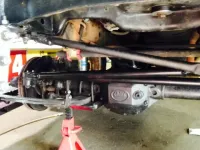Stiff ball joints and steering issues
billyballer
Jeeper
- Posts
- 145
- Media
- 3
- Thanks
- 1
- Location
- Oakland, CA
- Vehicle(s)
- 1986 CJ7: Renix 4.0 swap.
1969 MGB GT
1974 Capri race car
1970 Lotus Elan
1959 Lambretta
I have been chasing a steering problem since I swapped in a new front axle a few months back. It felt like a combination of bump steer, and problems with little corrections in steering causing over correction and wander.
I did pretty much everything, bushings, beefier tie rod/drag link, flipped them over the top of the knuckle, and alignment. The bump steer is now gone, and the jeep tracks better, but there is still an issue with the correction. If you need to make a minor correction while driving straight, the correction seems to always go to far the other way. I think this is caused by the steering not want to center up. While this seems like a castor issue, I checked an rechecked castor and it is well within spec.
After doing a ton of internet research I finally found one person who had a similar problem that they pinned on stiff ball-joints.
So I obtained the FSM section on how to check this. With drag link and tie rod disconnected, and a bolt running through the tie rod end hole, you can put a torque wrench on that bolt and the effort to turn the knuckle should be 10 ft/lbs or less through the full range. Sure enough mine was 15 ft/lbs on both knuckles.
I decided to pull the axles out and double check just in case I had a bad u joint. Well I do have a bad axle u joint, but even without the axle in the effort is still at 15 lb/ft.
My next move was to adjust the preload split nut. I pulled the knuckle off then reassembled and preloaded the nut to 45 instead of 50. Still too stiff.
My question is, What is the proper way to set the preload. The FSM says to tighten the bottom ball joint all the way before even installing the preload nut, but other folks I've read, run it in so it is protruding a little below the top knuckle casting, then tighten the bottom joint. I think I'm going to just order another set of ball joints and redo everything, just to be sure, but I want to do the job right.
It should also be noted that the bad u-joint can cause steering problems to. I've read a lot about steering issues on this site but had never heard of the stiff ball joints being the issue until now, so hope this info might help someone else sort their steering down the road.
I also noticed my steering box has a tiny bit of play. Barely noticeable by the naked eye but I can feel it when I rock the pitman arm with my hand. That is next on my list.
I did pretty much everything, bushings, beefier tie rod/drag link, flipped them over the top of the knuckle, and alignment. The bump steer is now gone, and the jeep tracks better, but there is still an issue with the correction. If you need to make a minor correction while driving straight, the correction seems to always go to far the other way. I think this is caused by the steering not want to center up. While this seems like a castor issue, I checked an rechecked castor and it is well within spec.
After doing a ton of internet research I finally found one person who had a similar problem that they pinned on stiff ball-joints.
So I obtained the FSM section on how to check this. With drag link and tie rod disconnected, and a bolt running through the tie rod end hole, you can put a torque wrench on that bolt and the effort to turn the knuckle should be 10 ft/lbs or less through the full range. Sure enough mine was 15 ft/lbs on both knuckles.
I decided to pull the axles out and double check just in case I had a bad u joint. Well I do have a bad axle u joint, but even without the axle in the effort is still at 15 lb/ft.
My next move was to adjust the preload split nut. I pulled the knuckle off then reassembled and preloaded the nut to 45 instead of 50. Still too stiff.
My question is, What is the proper way to set the preload. The FSM says to tighten the bottom ball joint all the way before even installing the preload nut, but other folks I've read, run it in so it is protruding a little below the top knuckle casting, then tighten the bottom joint. I think I'm going to just order another set of ball joints and redo everything, just to be sure, but I want to do the job right.
It should also be noted that the bad u-joint can cause steering problems to. I've read a lot about steering issues on this site but had never heard of the stiff ball joints being the issue until now, so hope this info might help someone else sort their steering down the road.
I also noticed my steering box has a tiny bit of play. Barely noticeable by the naked eye but I can feel it when I rock the pitman arm with my hand. That is next on my list.

 mike
mike
